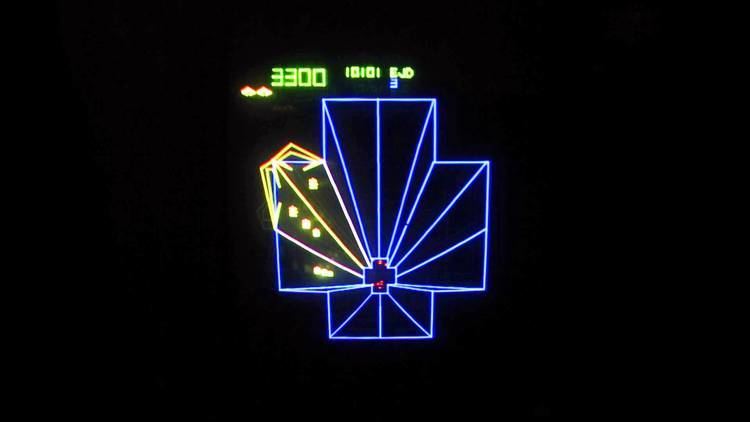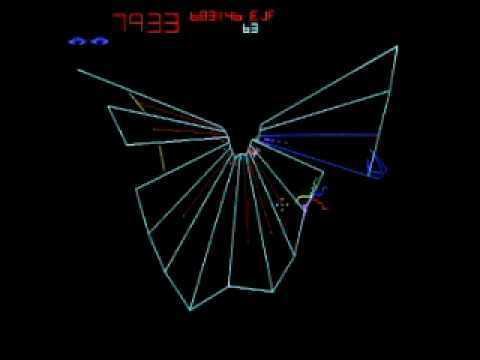9 /10 1 Votes9
Publisher(s) Atari Inc. Initial release date 1 October 1981 Developer Atari Genre Shoot 'em up | 4.5/5 ArcadeThunder Sound POKEY x 2 CPU MOS Technology 6502 | |||||||||||||||||||||||||||||||||
 | ||||||||||||||||||||||||||||||||||
Mode(s) Up to 2 players, alternating turns Cabinet Standard, cabaret, and table Display Vertical orientation, Vector (color), size: 19 inch Platforms Similar Atari games, Shoot 'em up games | ||||||||||||||||||||||||||||||||||
Tempest is a 1981 arcade game by Atari Inc., designed and programmed by Dave Theurer. It takes place on a three-dimensional surface, sometimes wrapped into a tube, which is viewed from one end and is divided into a dozen or more segments or lanes. The player controls a claw-shaped spaceship (named Blaster) that crawls along the near edge of the playfield, moving from segment to segment.
Contents
- Gameplay
- Production
- Sequels
- Contemporary ports
- Re releases
- Unofficial versions
- Reception
- Tempest in popular culture
- References

Tempest was one of the first games to use Atari's Color-QuadraScan vector display technology. It was also the first game to allow the player to choose their starting level (a system Atari dubbed "SkillStep"). This feature increases the maximum starting level depending on the player's performance in the previous game, essentially allowing the player to continue. Tempest was one of the first video games to sport a progressive level design in which the levels themselves varied rather than giving the player the same layout with increasing difficulty levels.

Gameplay

The objective of Tempest is to survive as long as possible and score as many points as possible by clearing the screen of enemies that have landed on the playing field. The player's ship can rapid-fire shots down the tube, destroying any enemies within the same segment, and is also equipped with a Superzapper, which destroys all enemies currently on the playfield once per level. (A second use of the Superzapper in a level destroys one random enemy.)

Enemies swirl around at the far end of the playfield, then enter the playfield and move toward the player. There are multiple types of enemy, each of which has different behavior. At higher levels, some enemies leave a spike in the middle of the lane as they travel toward the player; a spike can destroy the player's ship when the player warps out to the next playfield. Other enemies travel to the player end of the playfield and then flip from lane to lane, killing the player if they move to the lane that the player is on; firing while the enemy is changing from an adjacent lane kills this type of enemy. When all enemies in a level are destroyed or reach the near end of the playfield, the player "warps" to the next level by traveling down the playfield. As the player warps to the next level, he or she must avoid or shoot away any spikes. The player loses a ship when an enemy comes into contact with their ship, shoots it or otherwise destroys it, or if the ship hits a spike while warping. At certain point thresholds, the player earns a new ship. The game is over when the enemies destroy all of the player's ships.

The game consists of sixteen screens with unique geometric shapes, some of which are closed tubes that allow the player to loop around, while others are open fields that have distinct left and right endpoints. When all sixteen screens have been played, the sequence repeats with a different color scheme and a higher difficulty level, including the invisible (black) levels (65–80). Each sequence of levels adds additional enemies that are faster and more deadly to the player's ship. The numbered levels stop incrementing after level 99 and a random one of the 16 variations will appear after each player death or the successful completion of subsequent levels.
Production
The game was initially meant to be a 3D remake of Space Invaders, but such early versions had many problems, so a new design was used. Theurer says that the design came from a dream where monsters crawled out of a hole in the ground. During the prototype stages the game was entitled "Aliens", to "Vortex" and finally titled, Tempest.
Three different cabinet designs exist for Tempest. The most common cabinet is an upright cabinet in the shape of a right triangle sitting on top of a rectangle, when viewed from the side. This cabinet sported colorful side art. A shorter and less flashy cabaret-style cabinet was also released with optional side art, and a cocktail-style table cabinet allowed two players to play at opposite ends of the table. In this configuration, the screen would flip vertically for each player.
Sequels
Jeff Minter created two authorized sequels, released long after the original game: Tempest 2000 (1994) for the Atari Jaguar (renamed Tempest X3 for the PlayStation port), and Tempest 3000 (2000) for Nuon enhanced DVD players. Minter also wrote two games inspired by Tempest: Space Giraffe (2007) and TxK (2014) After TxK was released for the PlayStation Vita, the current incarnation of Atari blocked release of the game for additional platforms.
Contemporary ports
Re-releases
Unofficial versions
Shortly after the original game was released, an arcade owner named Duncan Brown hacked the level data and made an altered, more difficult version: Tempest Tubes. It was eventually included with Tempest in the Hasbro compilation Atari Arcade Hits: Volume 1 for PC in 1999.
1980s home computer clones include Storm for the Dragon 32 published by Microdeal in 1982, Web War for the Acorn Electron and BBC Micro published by Artic Computing in 1985, Tubeway (1982) for the Apple II, Storm (1984) for the Tandy Color Computer, and Livewire!, an Atari 8-bit family type-in game printed in ANALOG Computing in 1983. The Tempest-inspired Axis Assassin (1983) was one of the first five releases from Electronic Arts.
Arashi is a 1992 freeware clone for the Apple Macintosh running classic Mac OS. This version's source code was made available on GitHub by the developer under the open source MIT license in 2013.
In 1999 a game enthusiast started the Tempest Code Project to reconstruct and document an assembly source code version.
Reception
Tempest is #10 on the KLOV's list of most popular games, tied with Centipede.
The game has been cited as an influence on the careers of video game designers Jeff Minter and John O'Neill.
